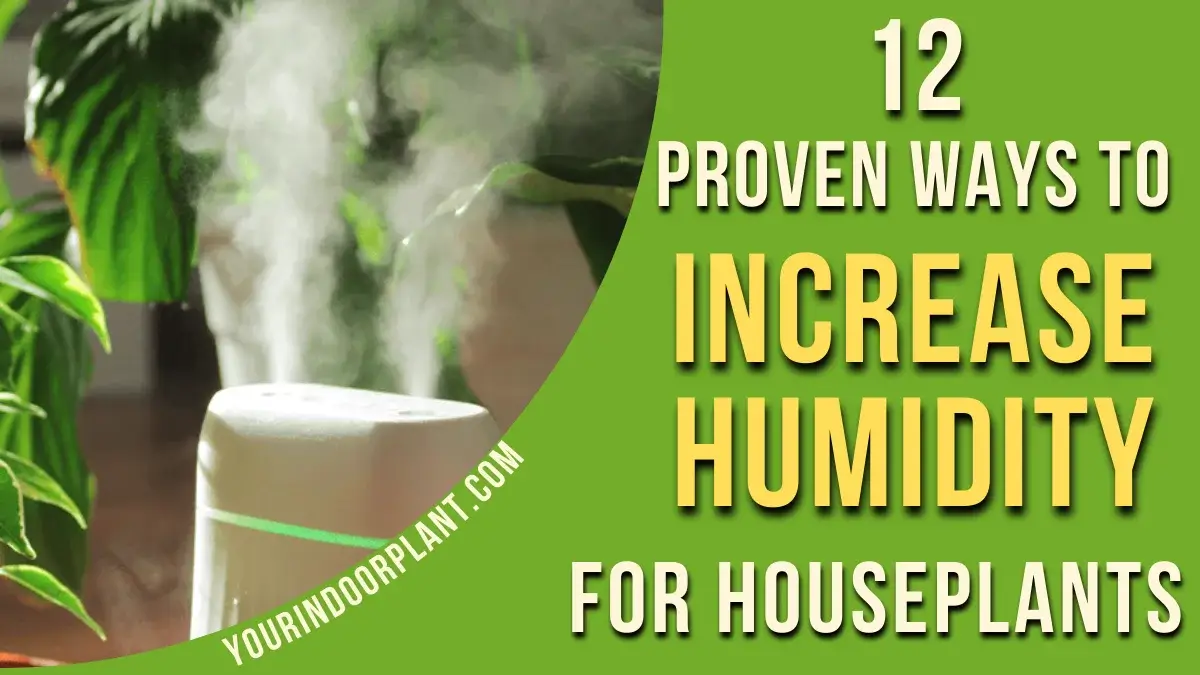How to Increase Humidity for Houseplants (12 Proven Methods)

You can increase humidity for houseplants using simple methods like misting, pebble trays, grouping plants, or running a humidifier. These tricks help recreate the tropical conditions many indoor plants love.
If your plants are looking a little sad — crispy leaf tips, curling edges, or slow growth — the air in your home might be too dry. Learning how to increase humidity for houseplants can make the difference between limp, stressed leaves and lush, thriving greenery.
Most indoor plants are happiest in 40–60% humidity (University of New Hamsphire), but in winter or in air-conditioned rooms, it can drop to 20–30%. That’s a big shock for a plant that’s used to rainforest conditions.
I’ve been there — my calatheas once curled so tightly they looked like cigars until I found the right methods.
1. Does Misting Plants Increase Humidity?
Use a fine spray bottle to lightly mist your plants in the morning. Aim for the tops and undersides of the leaves.
Misting adds a quick burst of moisture to the air and can help clean dust off leaves. I once tried misting daily, but it only worked for a few minutes, usually 10–15 minutes — so it’s more of a “refresh” than a long-term fix.
I mist my ferns and calatheas because they love the ritual, but I skip it for fuzzy-leaf plants like African violets — water on their leaves can cause spots and rot. Use distilled or rainwater to avoid white mineral marks.
2. How to Use a Pebble Tray for Humidity
Fill a shallow tray with pebbles, add water until it’s just below the top of the stones, and place your plant pot on top.
As the water evaporates, it raises the humidity right around the plant. It’s a gentle, low-maintenance method that works best for small to medium plants.
I keep a pebble tray under my peace lily. My hygrometer shows a 3–5% humidity boost in that corner. Combine this with grouping plants for even better results.
3. Should You Group Plants Together?
Arrange your plants close together so their leaves are near each other, but not touching.
Plants naturally release water vapor through tiny pores in their leaves — a process called transpiration. When they’re close, that moisture builds up in the air around them, creating a mini “humidity bubble.”
In my Portland home, I’ve noticed moving my calathea next to my monstera and philodendron, the humidity in that spot jumped from 38% to 46% in a week.
4. Best Rooms for High-Humidity Plants
Bathrooms, kitchens, and laundry rooms often have higher humidity thanks to steam and running water.
These rooms naturally trap moisture in the air, especially if they’re small and have limited ventilation.
I keep a Boston fern on a shelf above my shower. It gets bright indirect light and a daily steam bath — it’s doubled in size in six months.
5. Run a Humidifier for Consistent Moisture
Place a humidifier near your plants and run it for several hours a day, especially in winter.
A humidifier is the most reliable way to keep humidity steady. Small ultrasonic models can raise a room’s humidity by 10–15% in just a few hours.
I run mine for 6 hours a day in winter. My tropicals stay lush, and I clean the unit weekly to prevent mold.
6. Create a Terrarium or Glass Cloche Environment
Place small plants or cuttings inside a glass container or under a cloche to trap moisture.
Enclosed spaces slow evaporation, keeping humidity high and stable.
I root fittonia cuttings under a glass cloche. Even in my driest room, their leaves stay perky and vibrant.
7. Build an Indoor Greenhouse Cabinet
Convert a glass cabinet into a mini greenhouse with grow lights and a small humidifier.
The enclosed space lets you control humidity and temperature precisely — perfect for rare or sensitive plants.
My IKEA cabinet stays at 75% humidity year-round. My anthuriums and rare philodendrons thrive inside.
8. Add Aquariums or Water Features Nearby
Place an aquarium, indoor fountain, or even a decorative bowl of water near your plants.
As water evaporates, it adds moisture to the surrounding air.
My 20-gallon fish tank keeps the plant shelf next to it at 50% humidity without any extra effort.
9. Adjust Watering to Support Plant Transpiration
Keep the soil evenly moist for humidity-loving plants, but avoid soggy conditions.
Moist soil encourages plants to transpire more, which releases water vapor into the air.
My calatheas stay lush when I water as soon as the top inch of soil feels dry.
10. Choose Plants That Naturally Raise Humidity
Add large-leaf, high-transpiration plants like ferns, peace lilies, or areca palms to your collection.
These plants release more moisture, which can benefit nearby plants.
My peace lily cluster keeps my pothos from crisping in winter.
11. Measure and Monitor with a Hygrometer
Place a digital hygrometer near your plants to track humidity levels.
Measuring lets you see which methods are working and when you need to adjust.
I keep one in each plant zone — it’s satisfying to watch the numbers climb after trying a new method.
12. Control Airflow to Retain Humidity (The Overlooked Factor)
Move plants away from vents, fans, and drafty windows.
Air currents can strip moisture from the air faster than you can add it. Redirecting airflow helps humidity stick around.
After adding a vent deflector and moving my monstera, my humidity jumped from 42% to 55% without changing anything else.

Troubleshooting & FAQs
Do houseplants really need extra humidity indoors?
Yes — most tropical houseplants benefit from 40–60% humidity, higher than typical indoor levels in heated or air‑conditioned homes.
Which plants like high humidity the most?
Calathea, Maranta, Boston fern, Monstera, orchids, Alocasia, Peace lily, Anthurium.
Is a humidifier or pebble tray better for plants?
A humidifier is more effective for raising humidity; pebble trays give only a small, localized boost.
Can I increase humidity without buying anything?
Yes — group plants together, place water bowls near heat sources, or grow plants in enclosed containers/terrariums.
Conclusion
If you want a low-maintenance solution, start with grouping plants and adding a pebble tray. But if your collection is growing, a humidifier is the most reliable way.
Try one of these methods this week and tell me which worked best for your plants in the comments. I’d love to hear your results.
Your plants will reward you with greener leaves, stronger growth, and fewer brown tips. If you struggle with drooping leaves, check my article on Why Monstera Stems and Leaves Droop.
